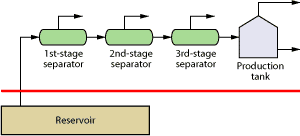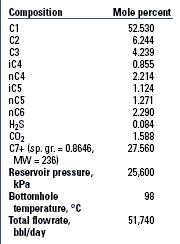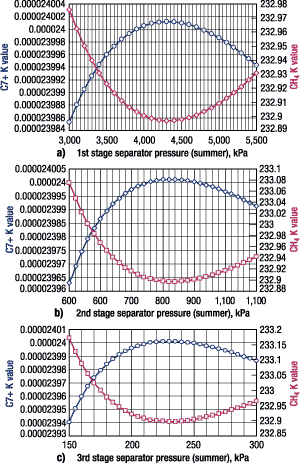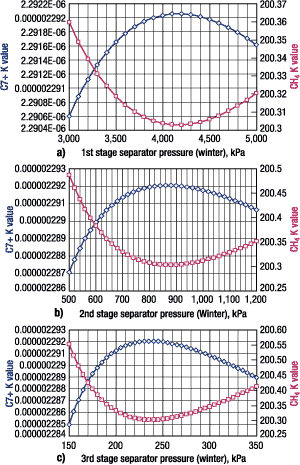Optimizing multi-stage separators' pressure set points maximizes oil recovery
In a simulation, the proposed, simple procedure increased oil production and API gravity at no added cost.
PRODUCTION TECHNOLOGYOptimizing multistage separators’ pressure setpoints maximizes oil recoveryIn a simulation, the proposed method increased oil production and API gravity at no added cost.Alireza Bahadori, National Iranian South Oil Company; and Saeid Mokhatab, Production & Lift Technology LLC To achieve good separation of gas-liquid mixture exiting crude oil production and maximize hydrocarbon liquid recovery, it is necessary to use several separation stages at decreasing pressures and then adapt the pressure setpoints to improve separation and recovery at minimum cost. A simple procedure, which does not require mass balance calculations, is proposed here to optimize separators’ pressures in the crude oil production unit. The proposed methodology determines the optimum pressures of separators in different stages of separation and consequently optimizes the operating conditions. In this study, the optimum pressures of separators in a 51,740-bbl/day oil production unit were determined. As a result, oil recovery was increased 146 bbl/day in summer or 184 bbl/day in winter, and the quality of total produced oil was improved by 0.5° API. BACKGROUND The principal means of surface separation of oil-gas mixtures is stage separation-a process at the wellhead in which gaseous and liquid hydrocarbons are “flashed,” or separated, into vapor (gas) and liquid (oil) phases by two or more separators arranged in series. The purpose of the stage separation is to reduce the pressure on the produced oil in steps to maximize stock tank oil recovery. If the separator pressure is too high, large amounts of light components will remain in the liquid phase at the separator and will be lost along with other valuable components to the gas phase at the stock tank. Conversely, if the pressure is too low, large amounts of light components will be separated from the liquid, and they will attract substantial quantities of intermediates and heavier components. Consequently, it is necessary to optimize separators’ pressure in winter and summer seasons. Considerable gains could be realized by performing process simulations to optimize the separator pressure for oil recovery. Produced reservoir fluids are complex mixtures of components with different physical characteristics. A wellstream flowing from the high-pressure petroleum reservoir experiences pressure and temperature reductions. The wellstream changes in character as gases evolve from the liquids. The manner in which the hydrocarbon phases are separated at the surface is critical to oil recovery, including the gravity of the stock tank oil and any VOCs that may be vented or recovered from the stock tank. The main objective of stage separation is to stabilize the resultant phases (gas and liquid) leaving the final separator, so considerable amounts of gas or liquid do not evolve from the final liquid and gas phases, respectively. Mechanically, there are two types of gas-oil separation processes: “differential” separation and “flash” or “equilibrium” separation. In order to explain these processes, it is convenient to divide hydrocarbon mixtures into three groups of components. These groups are:
In differential separation, where associated and free gas are removed at each stage of separation, the liberated gas is composed mainly of lighter components, and the pressure on the oil is reduced. When the gas is separated in this manner, a large amount of heavy and intermediate components will remain in the liquid, and there will be minimal oil shrinkage in the stock tank; therefore, greater oil recovery will occur. This is because the gas liberated earlier at higher pressure is not present at lower pressure to attract the intermediate and heavy components and pull them into the gas phase. To recover the gas fractions produced in the separators operating at medium and low pressure, it is necessary to re-compress them to the pressure of the high-pressure separator. In this case, all liquids collected in compressor suction drums are recycled to the production unit. However, for associated gas, re-compression is sometimes considered too costly; hence the gas produced from the low-pressure separator may be flared, depending on local regulations. When produced gas must be compressed to pipeline pressures, minimizing compressor horsepower may yield the most economic option.1 However, experience shows that horsepower optimization may not be as simple as maximizing stock tank oil recovery, and it has very little effect on oil production and API gravity.2 The quantities of gas and liquid recovered at a given pressure are determined by equilibrium flash calculations using an appropriate equation of state. This helps optimize the value of pressure that is set for each separator.3 Separator pressure has been shown to have a considerable effect on the recovery of crude oil.4 The vast amount of experimental and theoretical work that has been done on equilibrium ratio studies indicates their importance in solving phase equilibrium problems in reservoir and process engineering.5 Separator pressure optimization is a very important issue, in part because installed artificial lift performance and design depend on adjusted first-stage separator pressure.6 An extensive optimization approach for multistage separation processes has been presented by Bahadori and Zeidani.7 In equilibrium separation, pressure is maintained sufficient to keep gas in solution, and the liberated gas is not removed gradually but rather remains in contact with the oil until its instantaneous removal at the final separation pressure. This process causes a high proportion of intermediate and heavy components to attach into the gas phase, which results in high oil shrinkage and thus lower oil recovery. In practice, differential separation is first introduced in field separation when gas or liquid is removed from the primary separator. In each subsequent stage of separation, the liquid initially undergoes a flash liberation, followed by a differential process as separation occurs.7 As the number of stages increases, the differential aspect of the overall separation becomes greater. Separator calculations are performed to determine:
METHODOLOGY Modeling and design of many types of equipment for separating gas and liquids-such as flash separators at the wellhead, distillation columns and even a pipeline-assume that the phases are in vapor-liquid equilibrium. The criteria for thermodynamic equilibrium between vapor and liquid phases are: equal temperatures in both phases, equal pressure in both phases, and equal fugacity of each component in both phases. The vapor-liquid equilibrium constant (K) is centered around 1; values above this are increasingly volatile, while values below 1 are increasingly stable. K values are the essential ingredient for design and simulation of a separation system involving distillation columns, flash separators, etc. Numerous procedures have been devised to predict K values. These include equations of state, combining equations of state with liquid theory, or with tabular data and the corresponding state correlations. In this study, Peng and Robinson’s equation of state is used.8 Operating conditions are assumed initially in order to provide initial K values for methane and C7+ (heptane and larger) components. Pressure values are then changed incrementally to obtain curves for both K values vs. pressure. The vapor-liquid equilibrium constant is a function of pressure, temperature and composition. The computational steps of the proposed separator calculation are described below for a bubble-point reservoir fluid flowing into a surface separation unit consisting of four stages operating at successively lower pressures, Fig. 1.
The calculation method comprises the following steps: 1) Given the composition of the feedstream to the first separator and the operating conditions (i.e., pressure and temperature) of the separator, calculate the equilibrium ratios of the hydrocarbon mixture using a “pre-tuned” equation of state (Peng and Robinson’s equation of state in the current study). 2) Assume the total molal volume of the feed entering the first separator. Then, using the calculated equilibrium ratios, perform flash calculations to obtain the compositions and quantities, in moles, of the gas and the liquid leaving the stock tank. This should cover the current production rate for the production unit. 3) Incrementally change the first-stage separator pressure, then plot the calculated K values for C7+ and methane vs. the first-stage pressure. The best first-stage pressure corresponds to the minimum K value for methane and the maximum K value for C7+ components. 4) Incrementally change the second-stage pressure, then plot the calculated K values for methane and C7+ vs. the new second-stage pressure. The best second-stage pressure corresponds to the minimum K value for methane and the maximum K value for C7+. 5) Incrementally change the third-stage pressure, then plot the calculated K values for methane and C7+ vs. the third-stage pressure. The best third-stage pressure corresponds to the minimum K value for methane and the maximum K value for C7+. 6) Repeat the iteration from steps 3-5 until there would not be any variations in the K values of both methane and C7+ components compared with previous iterations. In this condition the best pressures would be optimum for different separation stages. RESULTS Given the fluid properties of a typical oil reservoir feedstream (Table 1) and applying the proposed methodology, we sought to optimize the separators’ pressures in a four-stage oil separation unit. HYSYS simulation software was used to simulate the separation.
Using the obtained optimum pressures for a four-stage separation process (Table 2), liquid production flowrate increased 146 bbl/day in summer or 184 bbl/day in winter by applying the optimum pressures to the separators in each stage of separation. This also increased in quality of produced oil by about 0.5° API. Since no additional equipment or instrumentation is required, it is worth applying the optimum pressures at each stage of separation. Only setpoint pressures need to be adjusted for the optimum pressure, at no cost.
Using the HYSYS process simulation software, the separators’ pressures were optimized to minimize the K value of methane and maximize the K value of C7+ in the stock tank liquid phase. Figures 2a-c shows the plot of these K values vs. pressure in each stage of separation in the summer conditions; Figs. 3a-c shows the plot of these K values vs. pressure in each stage of separation in the winter conditions. These plots determined the optimum pressure for each stage in summer and winter.
The proposed methodology determined the optimum separator pressure in each stage of separation, which increased oil production. Temperature is also an important parameter in optimizing the operations of the crude oil separation units. However, temperature of separation is a function of the ambient temperature, which is difficult to control.
|
||||||||||||||||||||||||||||||||||||||||||||||||||||||||||||||||||
- What's new in production (February 2024)
- U.S. operators reduce activity as crude prices plunge (February 2024)
- U.S. producing gas wells increase despite low prices (February 2024)
- U.S. oil and natural gas production hits record highs (February 2024)
- Dallas Fed: E&P activity essentially unchanged; optimism wanes as uncertainty jumps (January 2024)
- Enhancing preparedness: The critical role of well control system surveys (December 2023)










